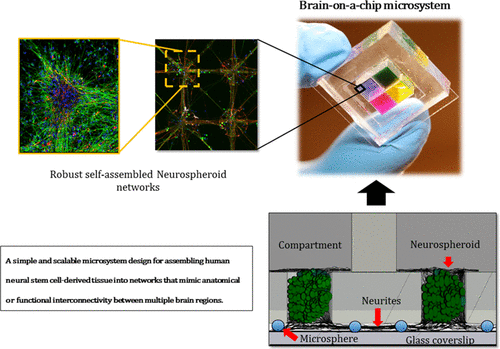当前位置:
X-MOL 学术
›
ACS Biomater. Sci. Eng.
›
论文详情
Our official English website, www.x-mol.net, welcomes your
feedback! (Note: you will need to create a separate account there.)
Brain-on-a-Chip Device for Modeling Multiregional Networks
ACS Biomaterials Science & Engineering ( IF 5.4 ) Pub Date : 2020-12-15 , DOI: 10.1021/acsbiomaterials.0c00895 Kenneth Ndyabawe , Michael Cipriano , Wujun Zhao , Mark Haidekker , Kun Yao , Leidong Mao , William S. Kisaalita
ACS Biomaterials Science & Engineering ( IF 5.4 ) Pub Date : 2020-12-15 , DOI: 10.1021/acsbiomaterials.0c00895 Kenneth Ndyabawe , Michael Cipriano , Wujun Zhao , Mark Haidekker , Kun Yao , Leidong Mao , William S. Kisaalita

|
Animal models are frequently used in drug discovery because they represent a mammalian in vivo model system, they are the closest approximation to the human brain, and experimentation in humans is not ethical. Working with postmortem human brain samples is challenging and developing human in vitro systems, which mimic the in vivo human brain, has been challenging. However, the use of animal models in drug discovery for human neurological diseases is currently under scrutiny because data from animal models has come with variations due to genetic differences. Evidence from the literature suggests that techniques to reconstruct multiple neurotransmission projections, which characterize neurological disease circuits in humans, in vitro, have not been demonstrated. This paper presents a multicompartment microdevice for patterning neurospheres and specification of neural stem cell fate toward networks of multiple neuronal phenotypes. We validated our design by specification of human neural stem cells to dopaminergic and GABAergic neurons in different compartments of the device, simultaneously. The neurospheres formed unrestricted robust neuronal circuits between arrays of neurospheres in all compartments of the device. Such a device design may provide a basis for formation of multineurotransmission circuits to model functional connectivity between specific human brain regions, in vitro, using human-derived neural stem cells. This work finds relevance in neurological disease modeling and drug screening using human cell-based assays and may provide the impetus for shifting from animal-based models.
中文翻译:

用于多区域网络建模的片上大脑设备
动物模型经常用于药物开发中,因为它们代表了哺乳动物的体内模型系统,它们是最接近人类大脑的模型,并且在人类中进行实验是不道德的。处理死后人脑样品具有挑战性,开发模仿体外人脑的体外系统也具有挑战性。然而,由于来自动物模型的数据由于遗传差异而具有差异,因此目前正在研究在用于人类神经系统疾病的药物开发中使用动物模型。来自文献的证据表明,尚未证明能够在体外重建表征人类神经系统疾病的多种神经传递预测的技术。本文介绍了一种多室微设备,用于对神经球进行模式化,并针对多种神经元表型的网络对神经干细胞命运进行规范。我们通过在设备不同隔室中同时对多巴胺能和GABA能神经元进行人类神经干细胞规范验证了我们的设计。神经球在装置的所有隔室中的神经球阵列之间形成不受限制的健壮神经元回路。这样的设备设计可以为使用人源性神经干细胞在体外形成特定于人脑区域之间的功能连通性的多神经传递电路的形成提供基础。这项工作发现了神经疾病建模和使用基于人类细胞的检测方法进行药物筛选的相关性,并可能为从基于动物的模型转变提供动力。
更新日期:2021-01-11
中文翻译:

用于多区域网络建模的片上大脑设备
动物模型经常用于药物开发中,因为它们代表了哺乳动物的体内模型系统,它们是最接近人类大脑的模型,并且在人类中进行实验是不道德的。处理死后人脑样品具有挑战性,开发模仿体外人脑的体外系统也具有挑战性。然而,由于来自动物模型的数据由于遗传差异而具有差异,因此目前正在研究在用于人类神经系统疾病的药物开发中使用动物模型。来自文献的证据表明,尚未证明能够在体外重建表征人类神经系统疾病的多种神经传递预测的技术。本文介绍了一种多室微设备,用于对神经球进行模式化,并针对多种神经元表型的网络对神经干细胞命运进行规范。我们通过在设备不同隔室中同时对多巴胺能和GABA能神经元进行人类神经干细胞规范验证了我们的设计。神经球在装置的所有隔室中的神经球阵列之间形成不受限制的健壮神经元回路。这样的设备设计可以为使用人源性神经干细胞在体外形成特定于人脑区域之间的功能连通性的多神经传递电路的形成提供基础。这项工作发现了神经疾病建模和使用基于人类细胞的检测方法进行药物筛选的相关性,并可能为从基于动物的模型转变提供动力。











































 京公网安备 11010802027423号
京公网安备 11010802027423号